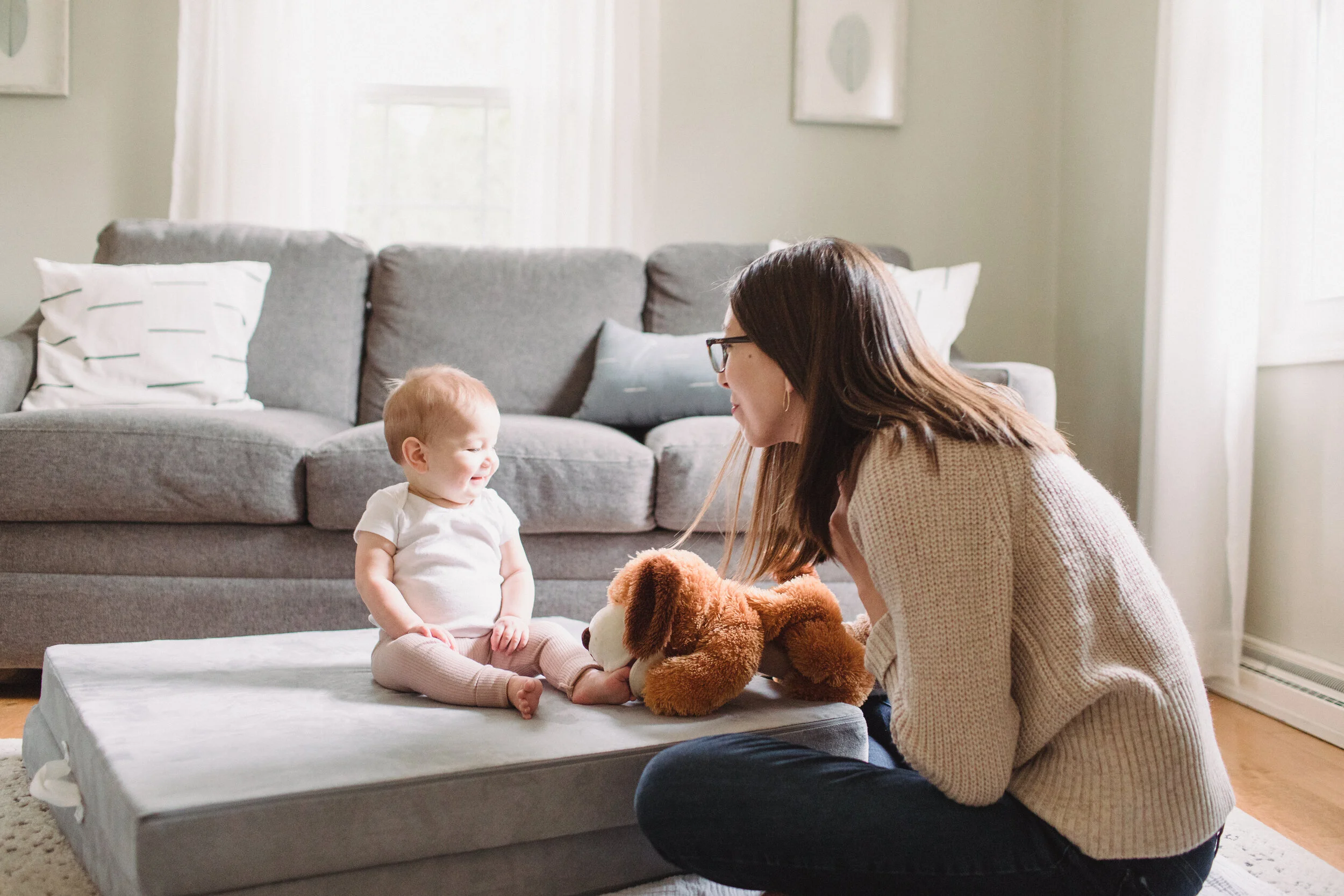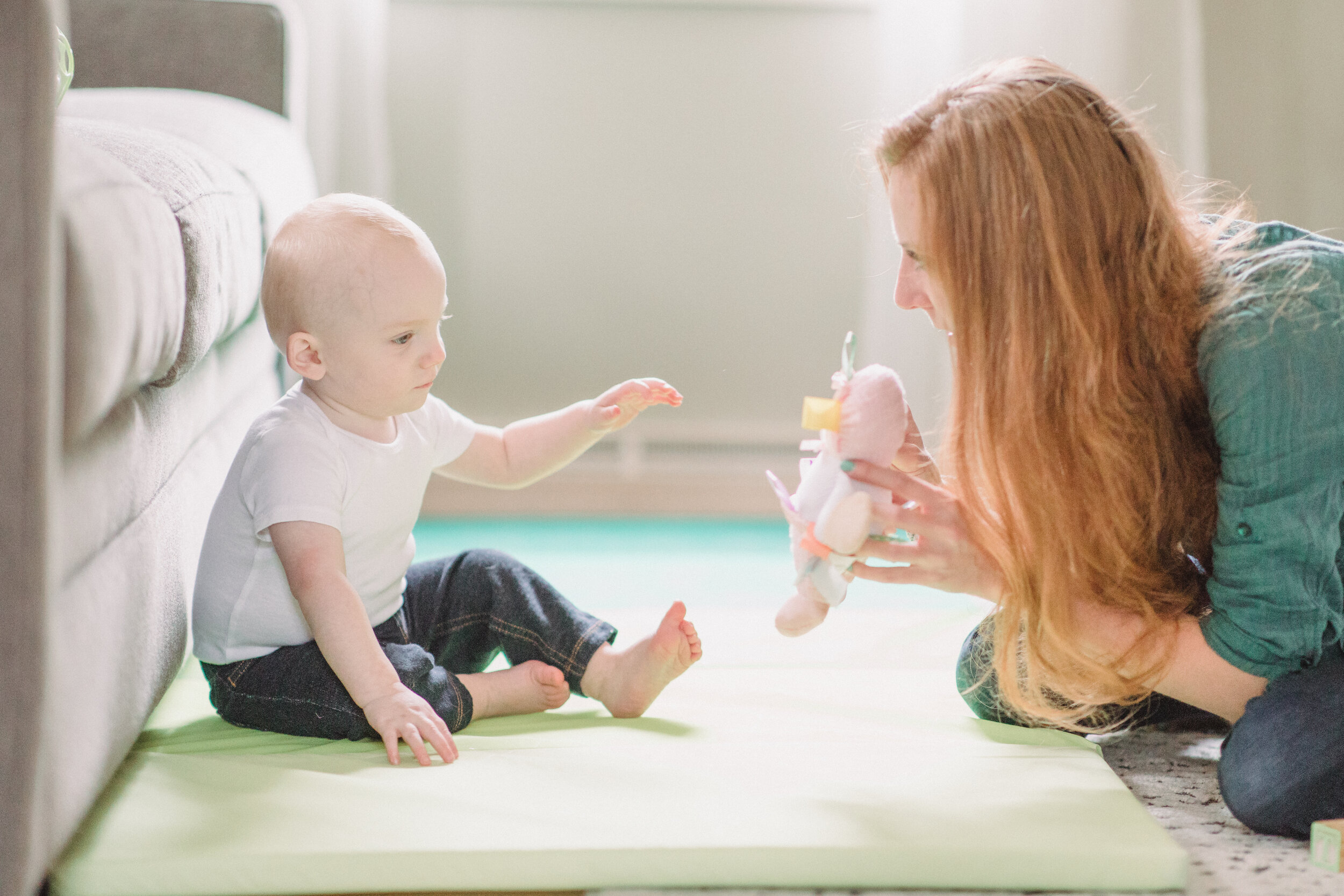You’re likely already spending time each day talking, reading, and playing with your baby. Engaging and bonding with your baby with these three activities when you can throughout the day are likely all he/she will need to develop communication skills on time. But not all interactions are created equal when it comes to enhancing speech and language development. All children will develop at their own pace, but making a few small changes to how you talk to your baby can make a big impact on your child’s ability to both understand and use language when he/she is ready.
Over the years, I have collected many tried-and-true communication enhancing strategies that require no prep, are simple and easily incorporated into the interactions you are already having with baby throughout the day. Below are my top 8 simple tips to use while talking to your baby that will optimize speech and language development.
Top 8 strategies for encouraging communication development:
1. Face-to-face: Simply turning to face your baby when playing or speaking is a simple way to enhance your interactions. This allows your baby to see your facial expressions, watch your mouth form sounds and words, and draws baby’s attention to what you are doing and saying.
2. Hold toys and books near your mouth: Once you are face-to-face with baby, this is a simple addition. Occasionally while talking about a specific item or picture in a book, bring the item up near your face and name what you are holding. This helps draw attention to your mouth so baby can see how you move your lips, tongue, and jaw to form different sounds and words.
3. Narrate: Talk about what you are doing throughout the day. At first, it may seem a bit strange to talk out loud to a baby who can’t yet engage in conversation with you, but it is a great way to expose baby to words and concepts throughout the day. Repeated exposure to these concepts will especially help baby learn the words and routines that are used most throughout your day.
4. Imitate: Babies learn to communicate with us by imitating what they see, and they learn to imitate by us first imitating them. As soon as your baby comes home from the hospital, spend time each day face-to-face, imitating or repeating the sounds and facial expressions your baby makes. Over time, baby will learn to respond in a back-and-forth interaction as the foundation for later imitation of gestures, sounds, and words.
5. Simplify: Use shorter, 4-7 word sentences when speaking to your baby to simplify and reduce the number of words baby needs to attend to and understand in each sentence (e.g., Look! A ball.”).
6. Use “baby talk:” Whether you love or hate it, speaking in “baby talk” or motherese/parentese is amazingly helpful to your new baby as he/she learns language. Parents in all cultures, speaking in all language use a form of simplified higher-pitched, sing-song speech when interacting with babies, and there is good reason. Parentese is slower, more repetitive, and exaggerates each sound in words so babies can more easily comprehend what they are hearing.
7. Use Gestures: Pairing a gesture with the words you say is a great way to help your baby learn new concepts and words as he/she can both hear and see the word. Babies often learn to use gestures before spoken words because they are easier to see and copy. Baby sign is an example of meaningful gesture use some families choose to use (more on why we use and encourage baby sign in a future post!).
8. No pacifier during awake time: Babies need to learn to use the tongue, lips, cheeks and jaw muscles in different ways before they can articulate or say sounds. Babies actually “rehearse” the mouth movements they see adults using when speaking to them long before they ever attempt to say those sounds. Limiting the ability to freely move the tongue, lips, and jaw during play can limit a baby’s ability to practice these movements.
These tips are helpful for all children, including those with identified or suspected speech and language delays or disorders. In most cases, a child’s speech and/or language delay or disorder has no known cause and was not brought on by something a caregiver did or did not to at home. But, what we do know is that children progress better with speech and language therapy when parents are implementing good communication strategies at home too. Making a few small changes to how you talk to your baby can make a huge impact on when and how easily he/she learns to understand and use words and will set the stage for later learning and literacy skills.
Use our milestone checklists to track your child’s skills and progress and always speak with your pediatrician if you are concerned about your child’s speech or language development. There are speech and language delays and disorders that are unavoidable and require early detection and prompt intervention by a licensed SLP.
Communication between parent and child is critical for bonding and connectedness. Taking time to both observe how and why your baby is already communicating with you, while using these simple strategies will help your baby progress from precious newborn grunts and coos to sweet first words and you can feel confident that your everyday interactions are helping baby move forward on his/her own timeline.
Jaclyn
We’re Bree & Jaclyn
Pediatric therapists and moms with a mission to empower you with knowledge to encourage your baby’s development and continue confidently into your parenthood journey.
If you have any questions, please feel free to leave a comment below and we will get back to you. As always, the information we share is meant to provide general education and tips and is not intended as medical advice. If you have a specific question or concern about your child’s development, please speak directly to your child’s doctor or therapist.







